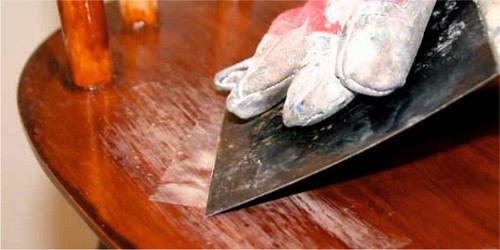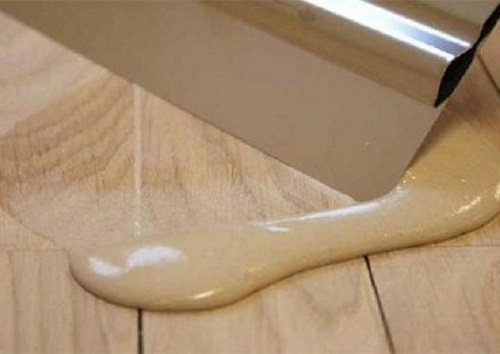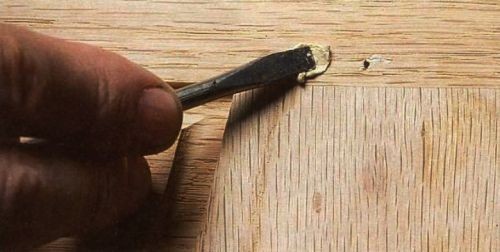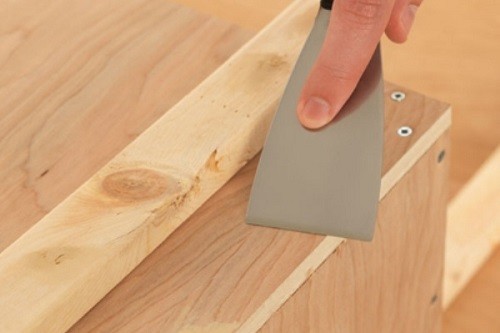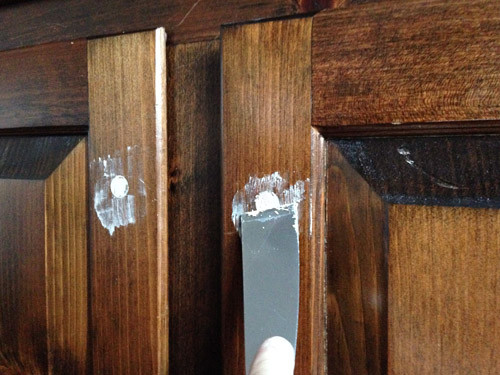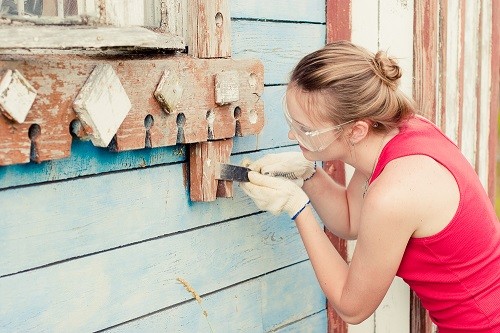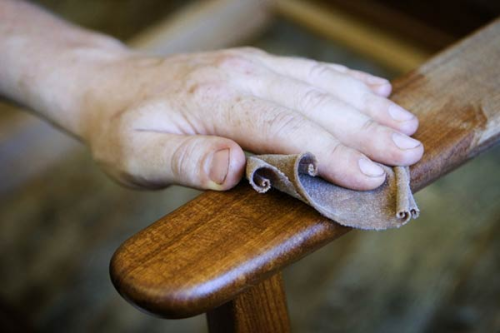
Tree putty: Properties and application Building materials
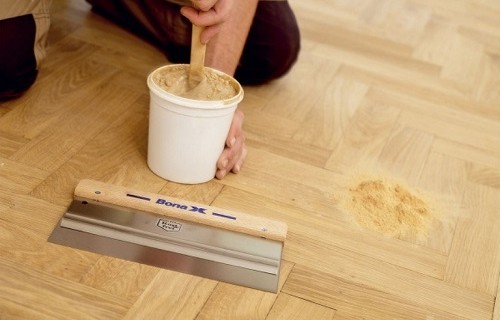
Wooden products, woods and floors from this natural material have always been popular. In fact, this is one of the first building materials in the history of mankind. Unfortunately, with all its advantages, a tree is not characterized by high strength, and sometimes unsightly cracks and holes spoil all the beauty. Wood putty allows you to quickly disguise any surface defects, returning it the former appearance.
Content
Types of spacure
Wood putty is used to hide all sorts of minor wood defects, such as gaps, cracks, emptiness, holes that remain from nails, etc. distinguish between several types of such decorative maps depending on the composition. Manufacturers also produce different shades of putty to match the most accurate species of wood (oak, cherry, nut, pine, etc.).
Putty on solvents
The spacure, made on the basis of the solvent, was used for quite a long time in the woodworking production of both amateurs and professional joiners. It was the first kind of putty, during the operation and experiments on which all other varieties were invented.
Solvent compositions are characterized by high strength, but they can be chemically unsafe and have an unpleasant smell. Another thing is water-based putty.
Water-based spacure
Water-based spacure is completely safe for humans, animals and the environment. They are very simple in use, elastic and practically no smell. To remove excess the aqueous putty, it is not necessary to rub them out with a turpentine or acetone, as in the case of its "progenitor" - it is enough to just wipe the surface with a damp cloth.
Unlike the compositions on solvents, the aqueous putty dries in the bank is much slower, therefore it has a longer storage time after a disruption of packaging tightness. High adhesive abilities allow putty even on a polished surface.
Water based putty characteristics:
- effectively hides defects;
- can be used for grouting joints of the flooring;
- does not highlight harmful chemicals, even when heated;
- immune to the effects of moisture;
- durable;
- resistant to temperature drops, moreover, putty can protect wood from fire;
- high elasticity allows you to simulate any surface texture.
All of the above characteristics are manifested only after the complete pouring of the composition and in the case of proper application.
Oil-based spacure
If you need an outer spacing for a tree - take only oil. It is perfect for processing facades before painting. It has a powerful water-repellent effect and calmly transfers adverse climatic conditions. Any other composition quickly cracks and occurs.
The abundance of various shades allows you to choose a plaster in color and leave the natural texture of wood, without overlapping it with paint.
Oil plaster for external work is produced in tanks weighing from 0.5 kg to 15 kg, which is very convenient if you need to treat a large facade.
Polymer putty
Polymer or acrylic putty today takes particular popularity and applies almost for any construction or repair work. This is explained by its impeccable performance characteristics - durability, elasticity, lack of shrinkage, etc.
Due to the presence of polymers and plasticizers, putty can be used both for finishing dry rooms and wet (kitchen, bathroom, sauna). It is capable of not only to push moisture and transfer the temperature differences, but also to withstand a strong load. For this reason, the polymer putty is ideal for working with wooden floors (parquet, massive board).
Characteristics of the acrylic wood putty:
- High elasticity - the mixture fills even the smallest cracks and emptiness, it can be used to clog the joints of the boat.
- The absence of shrinkage is unlike other species, it suffices to put a putty once, and it will retain its shape after drying.
- Durability - depending on the operating conditions, the coating can serve from 3 to 10 years and longer.
- The price of putty on a polymer basis is noticeably above the oil or water, but the amount will pay off in the first years of use - when other putty cracks are cracking and tremendous, the polymer will serve for many years.
- Wide color palette.
- Ecology (can be used in sanitary zones).
- Reduces dust accumulation.
- Quickly freezes.
How to choose a spacure
Agree, it will be quite unacceptable to think that the whole range of putty on the tree will be equivalent to each other, be it solvents, polymers, or water base. A good putty should fill all the cracks, quickly stick and not to marry. It should also be easily polished and not to be sues with time. How to buy a wrapping on a tree of decent quality and the most appropriate for a specific type of work?
If you have to work with porous or fibrous wood rocks, for example, a beech, oak or nut, then it is better to give preference to bully putty. They are evenly distributed over the surface, filling the pores and practically without hiding the natural beauty of the texture of the tree. Such formulations are commonly used before coating of parquet varnish or countertops.
With the help of a putty, you can get interesting decorative effects regardless of the wood of wood with which you work. So, to highlight the beautiful porosity of the tree, use the putty of the contrasting color or the shade of the finish coating. If you want to focus on beautiful material fibers, select the color of the putty, the most corresponding to the finish coating. Today, in the Russian market, Tikkurila Tykkurila Wood Popples enjoy the greatest popularity.
Useful advice: Before applying, be sure to check how the putty will look. Sat a little on the invisible area of \u200b\u200bthe coating and wait for drying. So, the fibers of certain tree breeds can be lifted by contact with wet compositions. In this case, the water putty is recommended to replace the solvent-based mask.
How to get the most successful result:
- Spend a test on a separate piece of wood before processing an expensive worktop or restore an old cabinet. Pay attention to all parts: Filling the pores, drying paces, shrinkage and ease of grinding.
- Buy a few shades of putty - rarely who are able to "on the eye" to determine the exact shade, especially since after drying the putty can be slightly lighter or darker. Often to achieve an optimal effect you need to mix multiple shuffle colors manually.
- Choose a putty suitable thickness - the aqueous compositions are more thick and well in contact with any surfaces, in contrast to solvent-based masons. If you do not need to very tightly score voids in the wood, as is done in the case of putty on solvents, choose polymer or water formulations.
Consider that the water putty will dry for quite a long time - first the film appears on the surface, which slows down the evaporation of moisture. For this reason, it is better to use putty on solvents to fill deep cracks, and to apply it in several layers, each of which is grinding before applying the following. - Be sure to take the location of the surface being processed. If these are outdoor work, you can use only oil putty - the water will not stand the environmental impact.
Wooden floor spike
Outdoor coverage has always been and will be one of the most sought-after. The tree is warm, pleasant to the touch, durable and beautiful, but, unfortunately, may suffer from unsperested blows or exposure to parasites. Putty wood for the floor allows not only to disguise defects, but also protect wood from fire, dampness, damage insects and rodents.
You can start to put down the floor covering as in the process of installing the new floor, and in the case of the repair of the old one. If you have noticed that the gaps were formed in the floor, quickly tempt them suitable with a putty putty.
If we are talking about the installation of a new floor covering, take the same parquet, then before finishing lacquer, it is necessary to sharpen it all over the area. So the foundation will become integrity, it will become smooth, waterproof and as smooth as possible, and the lacquer is better "grabble" with a coating. Application of putty in this case occurs with a spatula with small doses, thoroughly treating each crack.
Rules for applying Schpatleok
In order for the coating to be processed as natural as possible, certain conditions should be followed when working with plaster:
- It is possible to smear the cracks in the tree on the street at a temperature not lower than + 5c, otherwise the composition will be too viscous and will not be able to fill all the slots. The humidity of the air should be at most 75%.
- The processed surface should be prepared - to clean the voids that will be filled with putty, smeared with a dust with a dust rag, remove the old paint and varnish coating, if necessary, to clean the sandpaper.
- Apply a plastic blade with a plastic blade or stainless steel spatula.
- If you need to fill in a deep crack more than 1 cm, it is recommended to do this in several layers, giving each previous one to dry. The thickness of each layer should not be above 2-3 mm. Drying time depends on the composition of the putty (see in the instructions on the package).
Putty under painting
Contrary to popular belief, the paint does not mask, but, on the contrary, further focuses on the defects of wood (remember at least clumsy painted benches under each entrance). That is why there is a putty for a tree under painting.
To obtain an even beautiful coverage, it is extremely important to comply with the technology for the preparation of the tree and applying putty:
- Remove the old paintwork, if any.
- Carefully sand surface first emery paper No. 3, then No. 1 or No.0.
- Naked untreated wood should be covered with Olifa.
- Wipe the sandy surface with a damp cloth to rose fibers, then sand again.
- Swim dust and slip joints, slots and holes.
- Wait for the putty drying, stuck the surface and spend slightly over again so that there is a better grip with paint.
- Wipe dry rag and proceed to painting.
How to remove the old paint from the tree
If you want to renovate the old door or upgrade the cabinet, for this you need to remove the old paintwork. In most cases, especially if we are talking about painting the times of the USSR, the paint holds very firmly. If the pigment layer is thin, try to remove it with sandpaper, if not, use one of the following methods.
How to remove paint:
- Hot hair dryer - it's not about usual, but about a construction fene, which can be tightened with such hot air that paint from it is covered with bubbles and melts. After that, it can be easily written with a spatula. But in the case of wood it is worth being careful - from excessive heating the tree can be charring.
When working with a hairdryer, security equipment should be followed. Since the paint is melted from hot air, it highlights harmful chemicals, so the presence of a respirator is required.
Important: If there is a lead in the old paint, in no case use to remove a hairdryer or sandpaper.

- Chemical cleansing - if you need to remove a lead paint from a wooden surface, use special cleaning solvents. It is necessary to work with them only in thick rubber gloves, a respirator and safety glasses, because evaporation can harm and mucosa. If you plan to use a putty on a tree for doors, a cloth is better to remove from the loops and take it on the street, or work in a well-ventilated room.
When you consider the paint, neutralize the aggressive impact of the washing, processing the surface with the cutlery vinegar, then wipe with a wet rag.
Putty for wood with your own hands
You can buy a putty for wood in any building store, but you can do with your own hands, especially if we are talking about large volumes. It is quite simple to make it, and will be required for this completely ordinary materials that have each owner.
In addition, having mastered the recipe, you can vary the dosage of the ingredients, reducing the time of frozen or increasing the strength of the composition.
What ingredients will be required for the preparation of homemade putty on the tree:
- olife - 500 ml;
- animal glue 10% - 100 ml;
- skipidar - 125 ml;
- liquid Syccativ - 25 ml;
- liquid soap;
- dry chalk in powder.
If you need a large amount of putty, in proportion to the amount of ingredients.
How to cook putty:
- Animal glue pour into an aluminum saucepan and heat on slow fire, stirring continuously.
- Add soap, siccative, turpentine and olifer, mix thoroughly to uniformity.
- Squash in the pan chalk.
- Mix the mixture thoroughly to the consistency of thick sour cream.
- The only drawback is to apply such a putty, it is necessary hot, so difficulties may arise with large volumes.
Alternative wood putty recipe:
If you need to sharpen a very deep hole, for example, behind the plinth, it is better to use the mounting foam to score most of the space, and on top to shine with putty suitable color.




